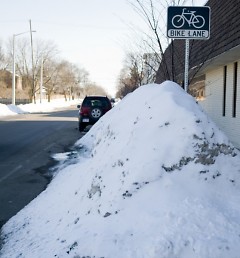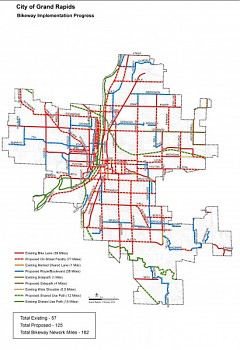As the sun starts to peek through the clouds and spread its warmth on Grand Rapids, residents are taking to the streets with their bicycles. But with this year's uncommonly brutal winter and the deteriorating quality of city streets, it may be some time before bike lanes are brought back to favorable riding conditions.
"Last year in the beginning of April we were ready to repaint our lines, but with this winter we may not be able to because we will be waiting for our street maintenance crews to repair the roads first," says Piotr Lewak, Grand Rapids Bike Planner and Traffic Engineer.
With 42 miles of on-street bike facilities, many of the city's bike lanes lay along roads severely affected by potholes. Bike lanes are typically located on the sides of the road where water gathers from melting snow and runoff. As the freeze-thaw cycle continues, these areas are often the most plagued by potholes, excess gravel and poor road conditions.
"This year will be more difficult than any other year to restore the streets to some kind of drivable condition," says Lewak. "Within the next month is going to be the most difficult time. This is where the snow is going to melt and flood the streets and at night is going to freeze and expand. Every cycle is going to add more to the destruction of the roads."
Due to limited funds and available road work crews, it may be mid-April before the city finishes filling potholes. After these repairs, crews can begin to repaint bike lane lines and begin construction of future on-street facilities. The most used bike lanes such as those along Lake Drive from East Town to Downtown will receive priority.
Another concern is the amount of snow piled in parking lanes which forces cars to partially park in the bike lane.
"If the city's priority is to fill the potholes, then I don't think we'll see a lot of extra attention given to clearing out the bike lanes," says Tom Tilma, the Executive Director of the Greater Grand Rapids Bicycle Coalition. "There are areas along the north side of Lake Drive, Cherry Street and Jefferson Avenue where the parking lane is completely clogged with snow and people are forced to park in the bike lane."
According to bicycle traffic counts carried out by the bike coalition, Grand Rapids has witnessed a 57% increase in cycling traffic from 2011 to 2013. The City has recognized the importance of bike lanes to sustainability efforts and has rapidly implemented approved bicycle lanes. Others believe that prevalent and well maintained bike lanes will help spur innovation and talent retention in the city.
"To attract younger talent, the creative class and... retain university students you really need to have a community that is making investments in pedestrian and bike friendly facilities," says Tilma.
While the city acknowledges the importance of bike lanes to the city's future, funding constraints pose a challenging reality. Resources for bike lane repairs come directly from the funding available for city roads.
"On May 6 a ballot will be put for voters to approve extension of income tax for another 15 years to help with repairing roads," says Lewak. "[Approximately 2-4% of] those funds will also be used for bike facilities. If the voters approve that tax extension then the city will be able to do more for both cyclists and motorists."
Lewak stresses patience for cyclists eager to get back on the roads and see further bike lane construction.
"There is only so much that can be done with existing budgets," says Lewak.
The Rapidian, a program of the 501(c)3 nonprofit Community Media Center, relies on the community’s support to help cover the cost of training reporters and publishing content.
We need your help.
If each of our readers and content creators who values this community platform help support its creation and maintenance, The Rapidian can continue to educate and facilitate a conversation around issues for years to come.
Please support The Rapidian and make a contribution today.

